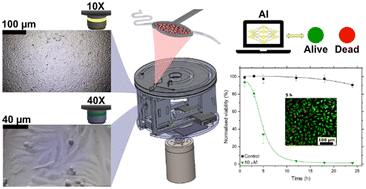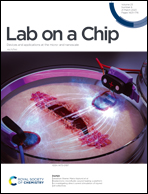Moving perfusion culture and live-cell imaging from lab to disc: proof of concept toxicity assay with AI-based image analysis†
Abstract
In vitro, cell-based assays are essential in diagnostics and drug development. There are ongoing efforts to establish new technologies that enable real-time detection of cell–drug interaction during culture under flow conditions. Our compact (10 × 10 × 8.5 cm) cell culture and microscope on disc (CMoD) platform aims to decrease the application barriers of existing lab-on-a-chip (LoC) approaches. For the first time in a centrifugal device, (i) cells were cultured for up to six days while a spindle motor facilitated culture medium perfusion, and (ii) an onboard microscope enabled live bright-field imaging of cells while the data wirelessly transmitted to a computer. The quantification of cells from the acquired images was done using artificial intelligence (AI) software. After optimization, the obtained cell viability data from the AI-based image analysis proved to correlate well with data collected from commonly used image analysis software. The CMoD was also suitable for conducting a proof-of-concept toxicity assay with HeLa cells under continuous flow. The half-maximal inhibitory time (IT50) for various concentrations of doxorubicin (DOX) in the case of HeLa cells in flow, was shown to be lower than the IT50 obtained from a static cytotoxicity assay, indicating a faster onset of cell death in flow. The CMoD proved to be easy to handle, enabled cell culture and monitoring without assistance, and is a promising tool for examining the dynamic processes of cells in real-time assays.

- This article is part of the themed collection: AI in Microfluidics


 Please wait while we load your content...
Please wait while we load your content...